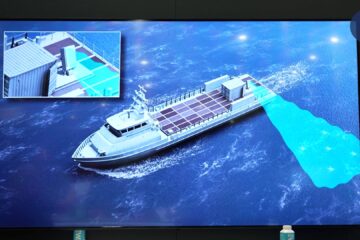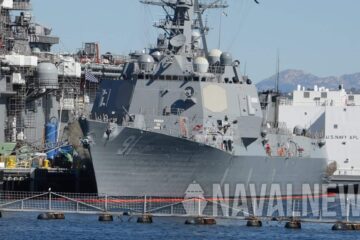Chief of Naval Operations, Adm. Mike Gilday and U.S. Congressmen Answer the Question that has Industry Wondering about Purpose-built Arctic Ships
When asked by Industry at Surface Navy Association (SNA) 2021 virtual Symposium on January 11, 2021 on if any of the future-built U.S. Navy warships such as the Littoral Combat Ships, Arleigh Burke destroyers, or Littoral Combat Ships will have hardened and strengthened hulls for Arctic and icy-water Polar operations, Chief of Naval Operations, Adm. Mike Gilday, answered:
“I’m not there yet in terms of armored hulls or turning our [war]ships into icebreakers.”
Admiral Mike Gilday, U.S. Navy at SNA 2021
Admiral Gilday noted that the United States Navy has participated in at least 20 Arctic Exercises, including ICEXs.
“ICEX 2020 is a three-week biennial exercise that offers the [U.S] Navy the opportunity to assess its operational readiness in the Arctic and train with other services, partner nations and allies to increase experience in the region, and maintain regional stability while improving capabilities to operate in the Arctic environment,” wrote Lt. Michelle Pelissero, COMSUBPAC, of the Northern Aerospace Defense Command (NORAD) News on March 6, 2020.
“The Seawolf-class fast-attack submarine USS Connecticut (SSN 22) from Bremerton, Washington, and the Los Angeles-class fast-attack submarine USS Toledo (SSN 769) from Groton, Connecticut, will conduct multiple Arctic transits, a North Pole surfacing and other training evolutions during their time in the region.” These two subs arrived at the Polar ice cap on March 4th, 2020.

“For more than 70 years, submarines have conducted under-ice operations in the Arctic region in support of inter-fleet transit, training, cooperative allied engagements and routine operations. The U.S. Submarine Force has completed approximately 100 Arctic exercises.”
Lt. Michelle Pelissero, COMSUBPAC, of the Northern Aerospace Defense Command (NORAD) News on March 6, 2020.
Admiral Gilday at SNA 2021 believes that the current fleet of U.S. Navy surface warships, built without ice hull-strengthening modifications, are sufficient for operations in the Arctic environments. Furthermore, by using the available surface naval forces to operate in the “High North” on exercises have shown and proven that the U.S. Navy can do these Arctic missions with the ship designs that the U.S. Navy currently possess and builds.
Congressman Rob Wittman, Ranking Member, House Armed Services Subcommittee on Seapower and Projection Forces, agreed during his presentation at SNA 2021 with the remark “Really a no-brainer that we have to get large [U.S. Coast Guard] icebreakers into the Arctic” as he sees an American surface naval presence vital for deterring Russia. The Congressman emphasized that the future United States Coast Guard’s Polar Security Cutters will be important in performing this “Arctic Presence role.”

Congressman Joe Courtney, Congressman Wittman’s presentation colleague at the SNA 2021 webinar, stated that the U.S. Coast Guard is busy educating the people, government, and the U.S. Navy on the importance of the Arctic and that the U.S. Coast Guard has to be treated as a partner in Arctic Security along with the U.S. Navy.
The U.S. Department of the Navy released last week its strategic blueprint for the Arctic titled a “Blue Arctic”. The document delivers an outline for the next two decades and provides strategic guidance on how the Department will apply naval power in the Arctic Region.






